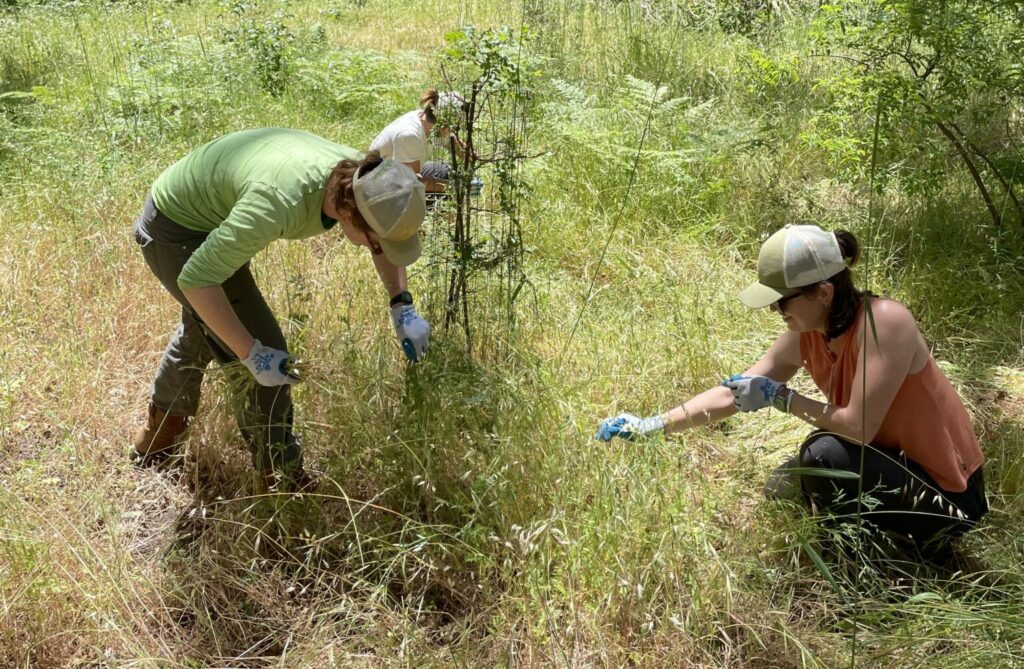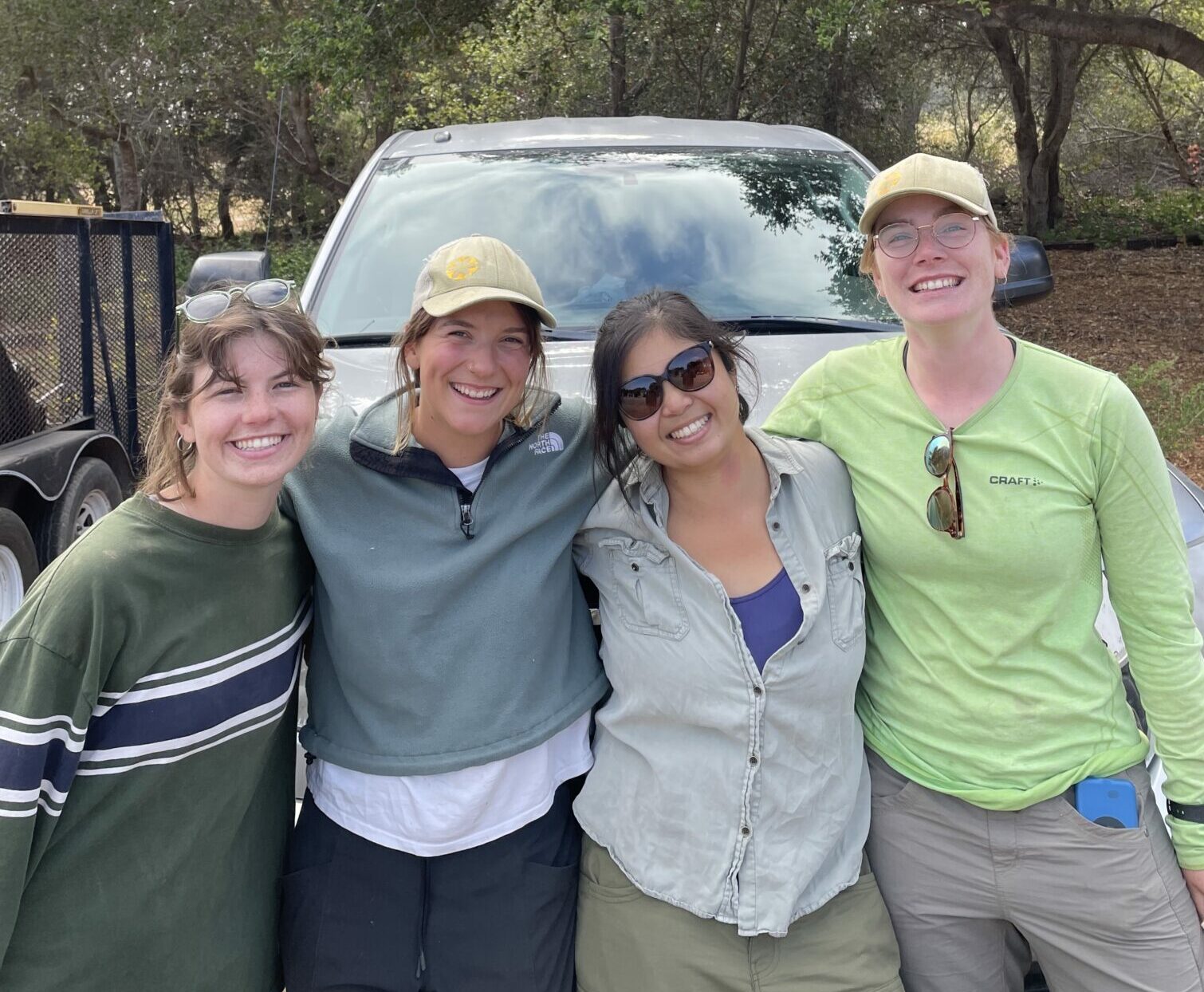2022 crew members pull Italian Thistle in the Enchanted Forest on The Preserve. Photo by Jackson Brooke.

Field Notes: Highlights from the 2022 Seasonal Restoration Crew
July 21, 2022
By Jackson Brooke, Restoration Manager, and the 2022 Seasonal Restoration Crew
When the Santa Lucia Conservancy launched the Grasslands Initiative in 2019, one of the goals that we set was treating 500 acres annually for invasive species. To achieve this ambitious goal, we hire a field crew of three to five Seasonal Restoration Technicians for six months each year, and each year we have seen our acreage increase as we build on the work of the previous crews.
Seasonal Restoration Technician Lead Ellie Stoermer and Seasonal Restoration Technicians Evany Wang, Jane Weichert, and Sophie Heny comprised our 2022 crew. They were tasked with removing invasive plant species from our grasslands by hand-pulling, spot spraying with herbicide, and spot mowing. As the plants progress through their life cycle, we adjust the method we use to take advantage of the plant’s changing vulnerabilities – at least, that’s the day-to-day goal.
The big picture goal of restoration is to “return a landscape to a healthy state that is resilient to future changes,” Evany says. “Nature and time are constantly shifting and so is society, so the best option is for us to adapt so that the landscape can adapt as well.”
The crew spent all day in the field from February through July, killing as many invasives as they could to help us to reach the 500-acre goal while developing mapping and plant ID skills and learning the safe and proper use of tools such as backpack sprayers, chainsaws, and brush cutters. As their time on the Santa Lucia Preserve drew to a close, we asked them a few questions to share their experience with the land, the Conservancy, and each other.

From Left to Right: Jane Weichert, Sophie Heny, Evany Wang, and Ellie Stoermer. Photo by Jackson Brooke.
1. How do you think this season will influence you in future roles?
Ellie Stoermer: “I always take something with me after a season is over, be it a new technique for controlling invasives or a new way of looking at a landscape. It is one of my favorite things about working seasonal jobs. After six months of working with the Conservancy, the thing I am most interested in carrying forward is a more discerning eye when it comes to restoration projects. Restoration is good work to do, but it is also hard work and when you have a limited amount of time and people it is important to be as effective as you can possibly be. It’s been great being a part of such a relatively young restoration program because there is room for flexibility. It also helps that the Conservancy exceeds at being dynamic in their approach to conservation. Asking questions like “did that go well?” and “is there a better way of doing it?” and then examining the answers critically means we are always improving the way things get done in the future. The easier the land is to work on the more you can do, even with a limited amount of time and people.”
Jane Weichert: “Learning how to use all the different equipment for each treatment method is important for future work in this field. As my first job after college, it has also helped me familiarize myself with a work environment vs. a classroom. SLC, however, is a great combination of both and I learned how to not take things so seriously – we got our work done but not in a stressful work environment. It was an environment that promoted work and learning.”
2. What were some of your favorite moments on the job?
Sophie Heny: “Some of my favorite memories (besides the obvious ones like saving a coyote pup or banding tricolored blackbirds) were the quieter moments that we were able to spend with each other and with the land. I have fond memories of climbing a grassy ridgeline to survey for French broom and really seeing the whole valley spread out before me for the first time, watching the mist inch towards us off the ocean as we hand-pulled in Robinson Saddle, lying in the grass with my crew talking about the books we were reading, and walks where we ID’d trees and birds and flowers. Mostly, I loved that I was able to work in a beautiful place I’d never been to before with people who became my close friends and call it a part of my career.”
Ellie Stoermer: “This season had a lot of wonderful moments, largely due to the fact that I had a pretty wonderful crew. But the moment that defined us best and, for that reason is one of my favorites, was probably one of our worst days. When the clouds were above us it was raining sideways, when the clouds were lower we were in cold fog and it was usually still raining sideways. Even when the rain let up a bit and the fog lifted, everything was so saturated that the moment we tried to cut down a shrub we got drenched again shaking off all the collected water. To make matters worse, some of our rain gear was less than adequate and everyone was soaked through. It was cold and miserable and we were making slow progress on a section that would have been overwhelming even in perfect weather. Eventually, we had to call it quits early because you can only operate a chainsaw to a certain level of safety when your hands are numb. As we sat in the truck with the heaters on full blast trying to warm up a bit before we made the drive back to the office, we were still joking and laughing, mostly at how cold and miserable everything was. It’s not hard finding a crew that works hard, but finding a crew that can work hard and still have a sense of humor about it is something special.”
Jane Weichert: “Some of my best memories working with my crew came on some of our worst days; when equipment failed, we were delirious from the heat, or soaking wet huddled in the car. We bonded best in these moments when all of us were trying to figure out how to proceed next. My last week in the field seemed to be four of these days in a row, but it was still an amazing last week. After my mower failed to turn on and I tried to switch the blade to another mower, which also failed to work (no worries I got it going eventually) we were headed to our next mow spot. Once there, we found an injured coyote pup on the side of the road. We all went into rescue mode without even thinking – with no discussion we all immediately took our places, two of us handling him and making him comfortable, one calling around to find where we could bring him, and I had the local knowledge to get him to the wildlife hospital. The pup made it there OK and has since been rehabilitated and released back into the wild. It was amazing to see how well we have learned to work together and trust each other to get everything done. This was and is an amazing crew and I’ll be lucky if my next crew is half as good as this.”
3. What advice would you give SLC’s next seasonal restoration crew?
Evany Wang: “Take advantage of the open communication that the Conservancy offers. Even if you think it’s futile as a seasonal employee, the Conservancy is transparent and willing to work with you, especially if you would like to continue working at nonprofits. Speak up and don’t feel burdened to do what is right for you, the Conservancy will back your needs. And if you want to learn something, go for it!”
Sophie Heny: “It was such a treat to be able to work intimately with such a beautiful and unique landscape as The Preserve. Take the opportunity once or twice a day to really appreciate where you are and how you are directly benefiting the land around you. I really enjoyed learning about this ecosystem and think it’s important to be grateful to work in a place this special that so few people get to see.”
If this sounds like the job you want, be sure to follow us on LinkedIn and look out for the job posting on our career page in mid-November.